Gatherings Spotlight: World War II Manuscript Collections
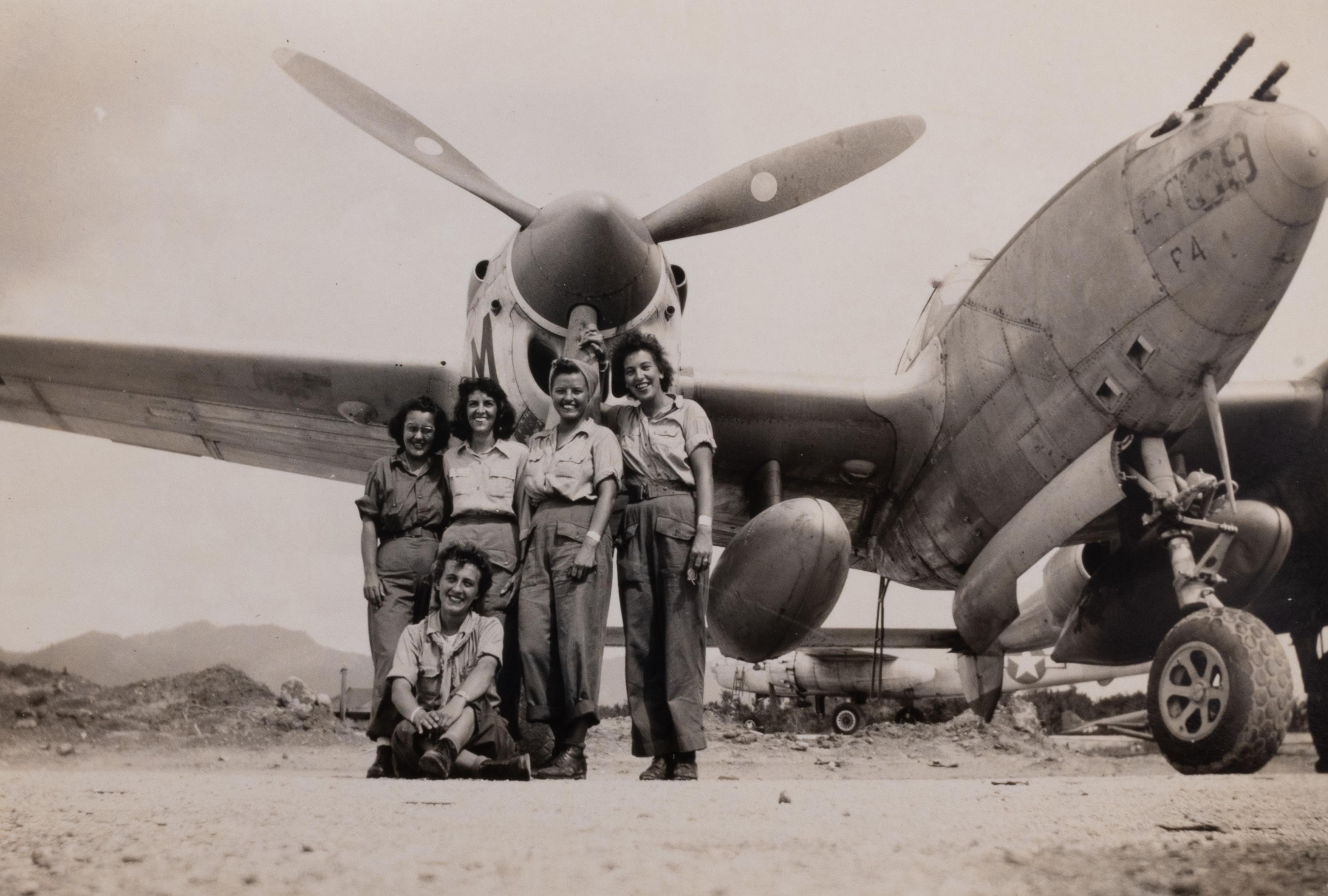
University Libraries 2022
About the cover:
“January 1944 marked the arrival of the first WAC in the Pacific Theater of Operations,” such as Phyllis Peirce (standing second from left) pictured here enjoying a moment of camaraderie posing in front of a Lockheed P-38 aircraft.
Caption Source: U.S. Army, Women in the Army

Message from the Dean
Welcome to the second issue of Ohio University Libraries’ magazine, “Gatherings Spotlight.” In this publication, we are highlighting several significant World War II manuscript collections from the Mahn Center for Archives and Special Collections.
The cornerstone of those manuscripts is the Cornelius Ryan Collection. In the 1950s, Ryan, a war correspondent and best-selling author of “The Longest Day,” solicited first-hand accounts of over 150 interviews and 900 questionnaires from civilians and military personnel across the United States, Canada, Great Britain, France and Germany who had participated in the D-Day invasion. These personal stories provide extraordinary insight into World War II through the eyes of the people who lived through it.
Highlighted also are collections of women who served as front-line war correspondents, such as Ann Stringer, a first-rate newspaper woman; Iris Carpenter, a war correspondent of the Daily Herald whose war experiences were later documented in the 1946 publication, “No Women’s World;” and Phyllis Peirce, who served as a WAC in the Pacific Theater with the Signal Intelligence Service.
Other collections brought to life in this issue are accounts of soldiers who were prisoners of war, pilots and scrapbook collections by military and civilians alike.
I hope you enjoy the personal stories behind each of the World War II collections and learn more about what people were saying and doing at home and overseas during a tumultuous period in the history of the world. These collections represent a sampling of the unique items held in University Libraries’ Mahn Center.
Thank you for your support of Ohio University Libraries.
Sincerely,
Dean of University Libraries
 Photo by Rich-Joseph Facun/Ohio University
Photo by Rich-Joseph Facun/Ohio University
Notes by the Archivist
Greta Suiter

World War II affected millions of people around the world. In the manuscript collections at Ohio University Libraries, there are documents that speak to the lived experience of some of those people. The experiences of war correspondents are well documented in these collections, as are the experiences of soldiers, prisoners of war, pilots and those back home in Athens County, raising money and sending love via letters to those far away. From the archival materials, we can see that the war was for some, both a great adventure filled with friendship and travels but was also physically and mentally difficult. In many collections, dealing with the waiting and uncertainty is as documented as experiencing the action and horror of war.
In the Cornelius Ryan World War II Collection, the largest and most well-known of these collections, we find many stories of individual’s experiences – surveys collected by Ryan are currently being digitized and transcribed – illuminating the raw material Ryan used to write his books.
In the Victor Bernstein collection, we can follow the events of the war via scrapbooks filled with his articles, and then we can examine photographs and ephemera he collected from his travels which powerfully document the dissolution of the rights of Jewish people in Germany, as well as the International Military Tribunal at Nuremburg in 1946.
And the most recent set of papers added to the Manuscript Collections is the Phyllis M. Peirce World War II Collection. Through her letters, scrapbooks and photographs we learn about the experience of a member of the Woman’s Army Corps who traveled to Southeast Asia at the end of the war as a cryptanalyst.
Each collection represents different viewpoints, experiences and voices of those affected by World War II. At The Robert E. and Jean R. Mahn Center for Archives and Special Collections, we provide access to all of the collections represented here and much more. Collections are used for scholarly purposes, classroom exercises and personal interest. All are welcome to explore the collections in person and online.
| 1
CORNELIUS RYAN COLLECTION OF WORLD WAR II PAPERS
World War II author and war correspondent
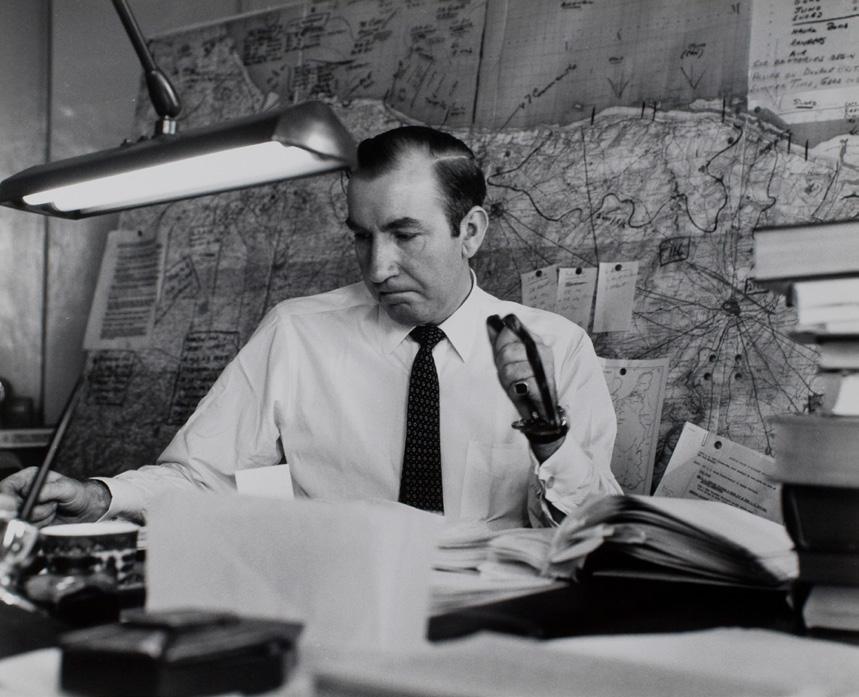
The Ryan Collection consists of material relating to World War II, the European Theater of Operations, in the form of his research papers and files for his three books: “The Longest Day,” about Operation OVERLORD, Normandy, France, June 6, 1944; “A Bridge Too Far,” about Operation MARKET-GARDEN, Holland, Sept. 17-26, 1944; and “The Last Battle” about the capture of Berlin, Germany, April 15-May 10, 1945. There are personal files for 3,072 individuals, both military and civilian participants of the battles, covering all nationalities. The files contain 2,551 questionnaires, 955 interviews, and numerous letters, diaries, accounts and observations.
(Right) This collection of personal stories about the battle on the shores of Normandy provides extraordinary insight into World War II. Pictured are men rescuing a D-Day landing craft on Omaha Beach.
(Below) In the 1950s, Ryan solicited first-hand accounts through interviews and questionnaires from civilians and military personnel across the United States, Canada, Great Britain, France and Germany who had participated in the D-Day invasion on June 6, 1944.
2 |

COLLECTION | 3
CORNELIUS RYAN COLLECTION OF WORLD WAR II PAPERS
(Right) In 1943, the three Allied powers, pictured left to right, Soviet Premier Joseph Stalin, U.S. President Franklin Delano Roosevelt and British Prime Minister Winston Churchill, met in Tehran, Iran to coordinate the military strategy against Germany and Japan.
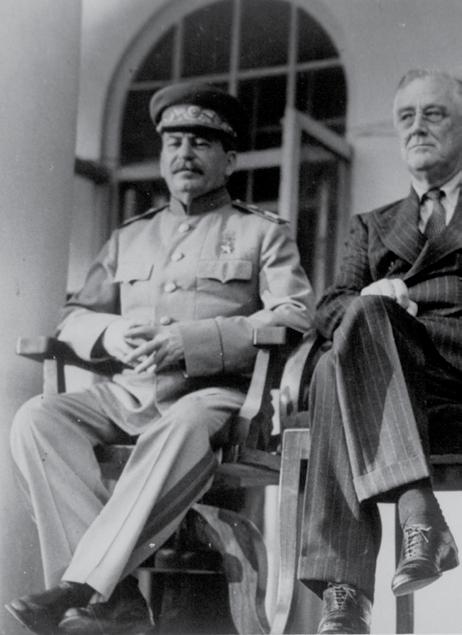
Caption Source: Office of the Historian
(Below) “Facing a two-front war in Europe and the Pacific … World War II became the global arena for a titanic struggle for control of the air.” Pictured are Allies’ planes dropping paratroopers on strategic military sites.


Caption Source: National Air and Space Museum
(Above) Pullout detail of image to the left.
4 |
(Above) Pictured is the transcript of the reel-to-reel tape, an audio recording wound between two metal wheels, about the Soviet’s 1945 operation in Berlin. The personal account was told by N.N. Popiel, a senior Soviet political officer.
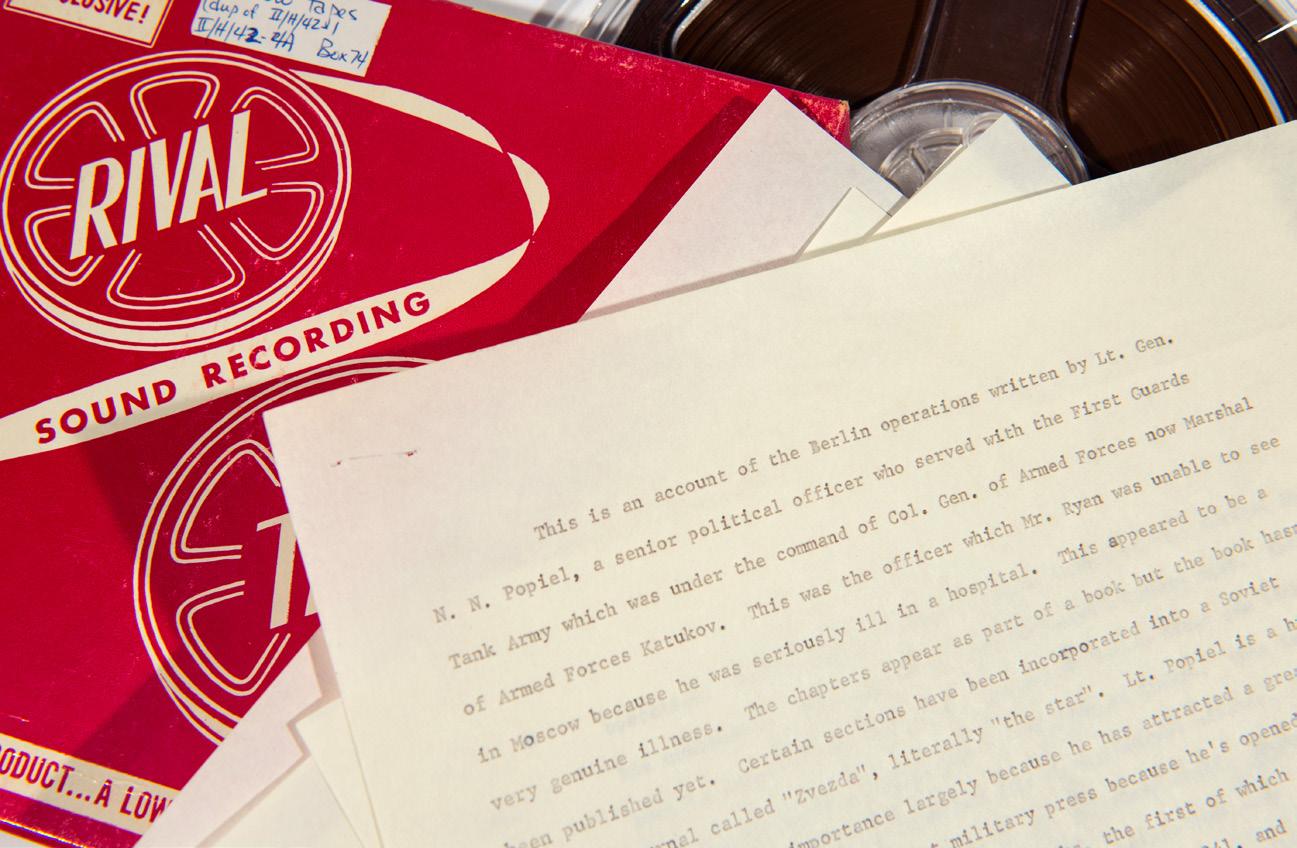
(Left) During the 25th anniversary of D-Day, journalists, like Cornelius Ryan pictured here, met with President Nixon as a memorial to Gen. Dwight Eisenhower and the troops who landed at Normandy Beach.

Caption Source: Portobello Dublin Ireland

| 5
CORNELIUS RYAN COLLECTION OF WORLD WAR II PAPERS
(Left) Corp. Jack Louis Bommer, serving in the parachute infantry of the 82nd Airborne Division, participated in the Sept. 1944 airborne assault on Holland. Some of his recollections, captured in his written questionnaire pictured to the right, were used in Ryan’s publication, “A Bridge Too Far.”
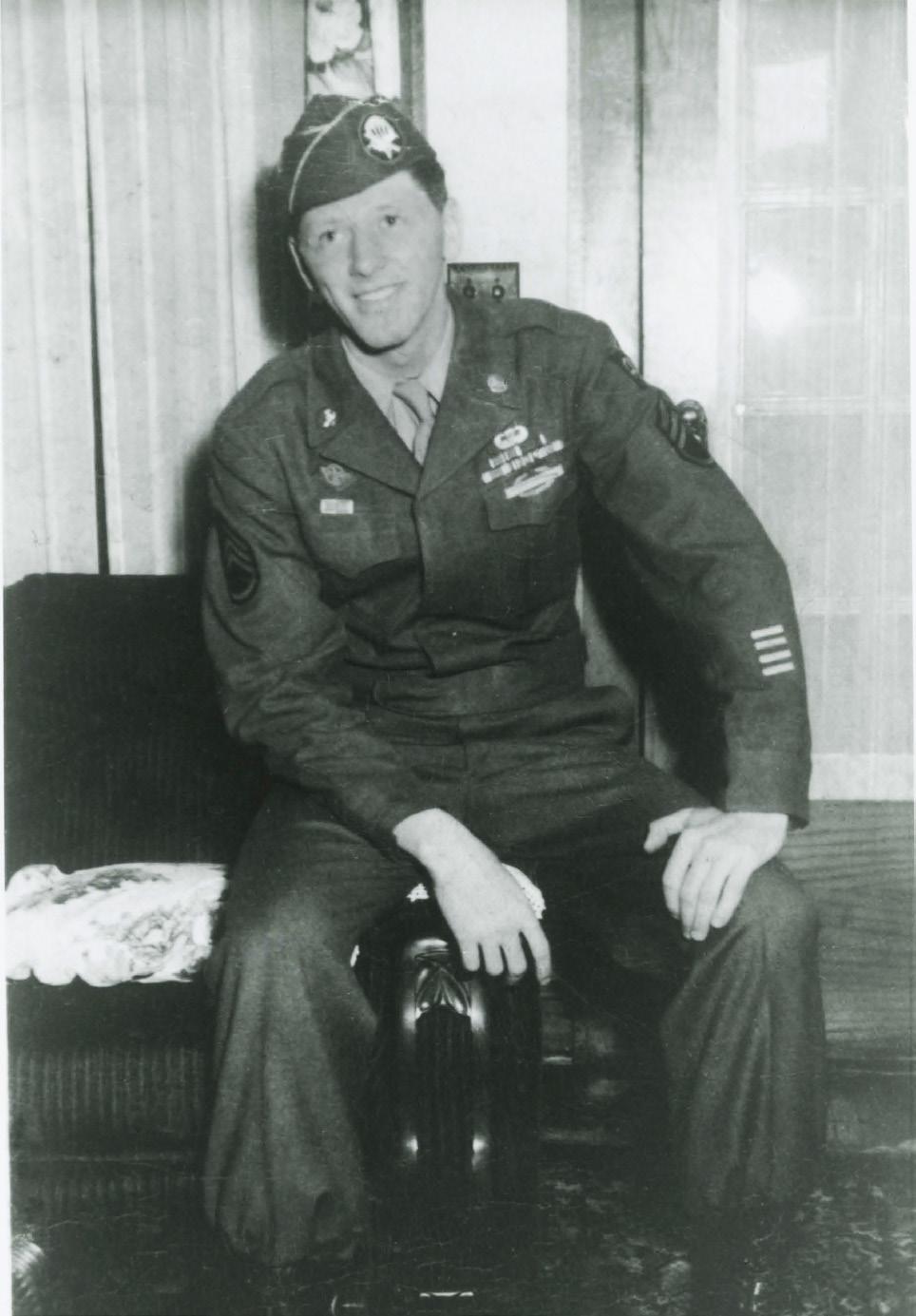
(Center) Questionnaires, like the one pictured from Corp. Bommer, provide first-hand accounts of soldiers’ personal experiences during WWII. University Libraries, in an international partnership with The Canadian Research and Mapping Association, is digitizing and transcribing those questionnaires to both heighten access and increase discoverability.

Caption Source: Ohio University Libraries
(Right) Pictured is Ryan’s typewritten notes about veteran Corp. Bommer’s questionnaire. One of his pullout quotes reads: “The trip from England to Holland had only one anxious moment... The emergency hatch sprung open. We thought the two closest men would be sucked out. Then…with a beautiful ‘flip’ of the tail end of the C-47, the pilot slammed the hatch door.”
6 |


| 7
United Press war correspondent
Ann Stringer was born in Eastland, Texas. She studied journalism in college, then moved to Columbus, Ohio with her husband William Stringer. They both worked for United Press and as a team they traveled to assignments in New York, South America and Europe. William was killed in France in 1944 after which Ann worked as a war correspondent in Europe alone.
The Ann Stringer collection contains 38 photographs of Stringer on assignment as a foreign correspondent, and photocopies of articles written by Stringer in Europe during and after World War II.
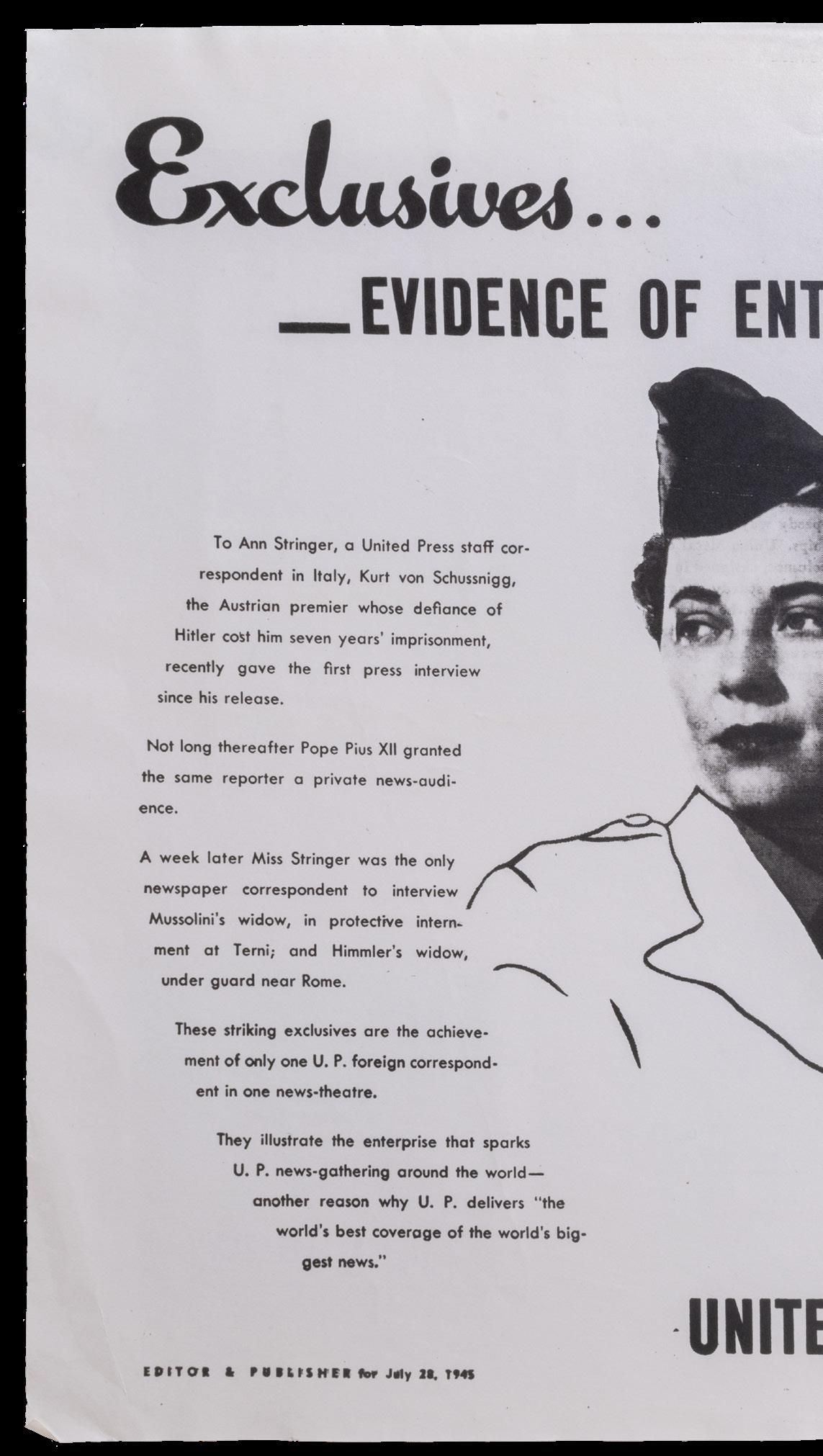
(Above) Pictured is Stringer making a radio broadcast from inside Bern, Switzerland, “the only neutral country with a common land frontier with Germany and the best point from which to observe.”
Caption Source: National Archives

ANN
8 |
ANN STRINGER COLLECTION

Stringer, center, interviews a group of soldiers in Torgau, Germany, the official strategic junction where in 1945 the Russians and Americans met for a friendly encounter during the advance against the Nazis.
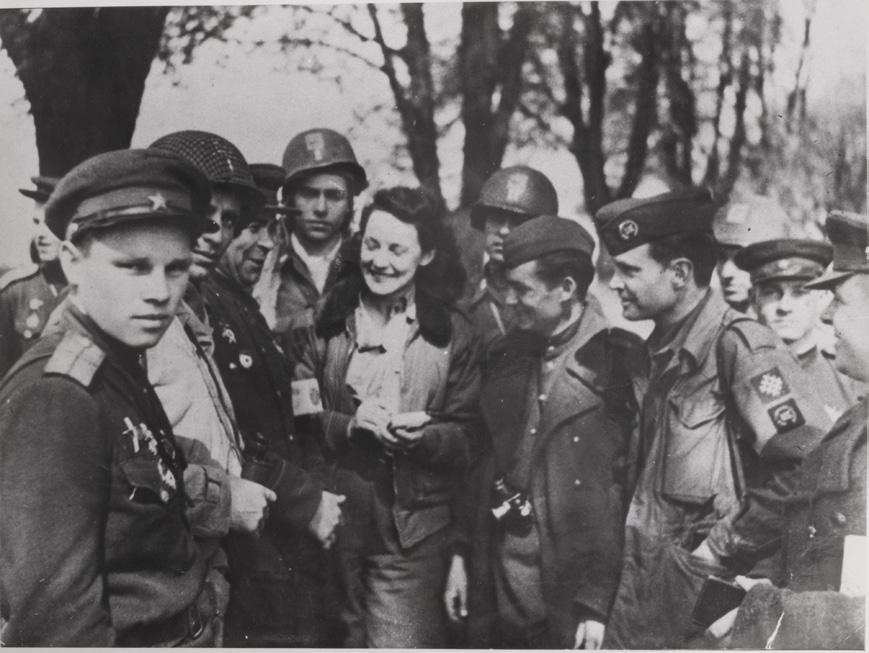
Stringer chats with soldiers from the U.S. First Army at Remagen Bridge, about 14 miles south of Bonn, Germany. The U.S. First Army captured one of the last bridges that remained standing across the Rhine River.
Caption Source: U.S. Army Corps of Engineers
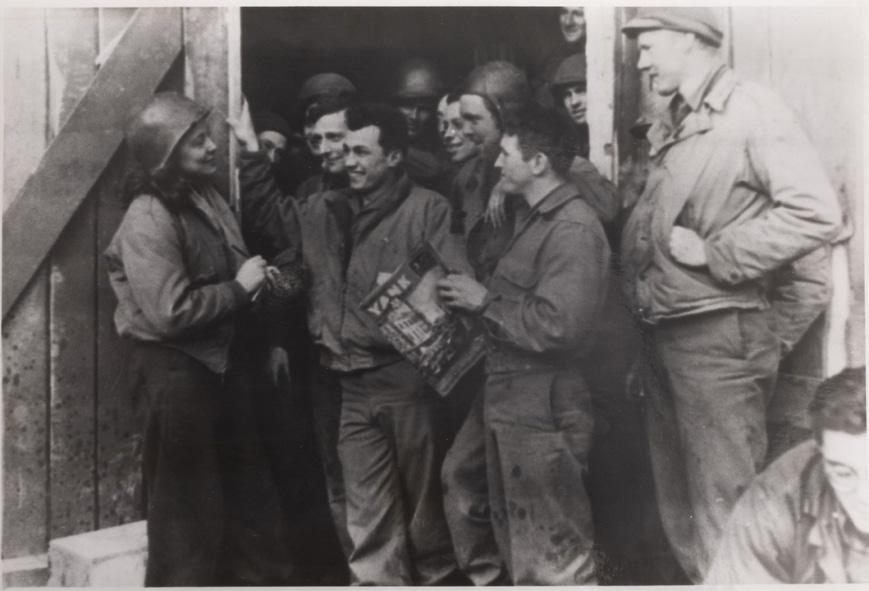
| 9
Caption Source: All That’s Interesting
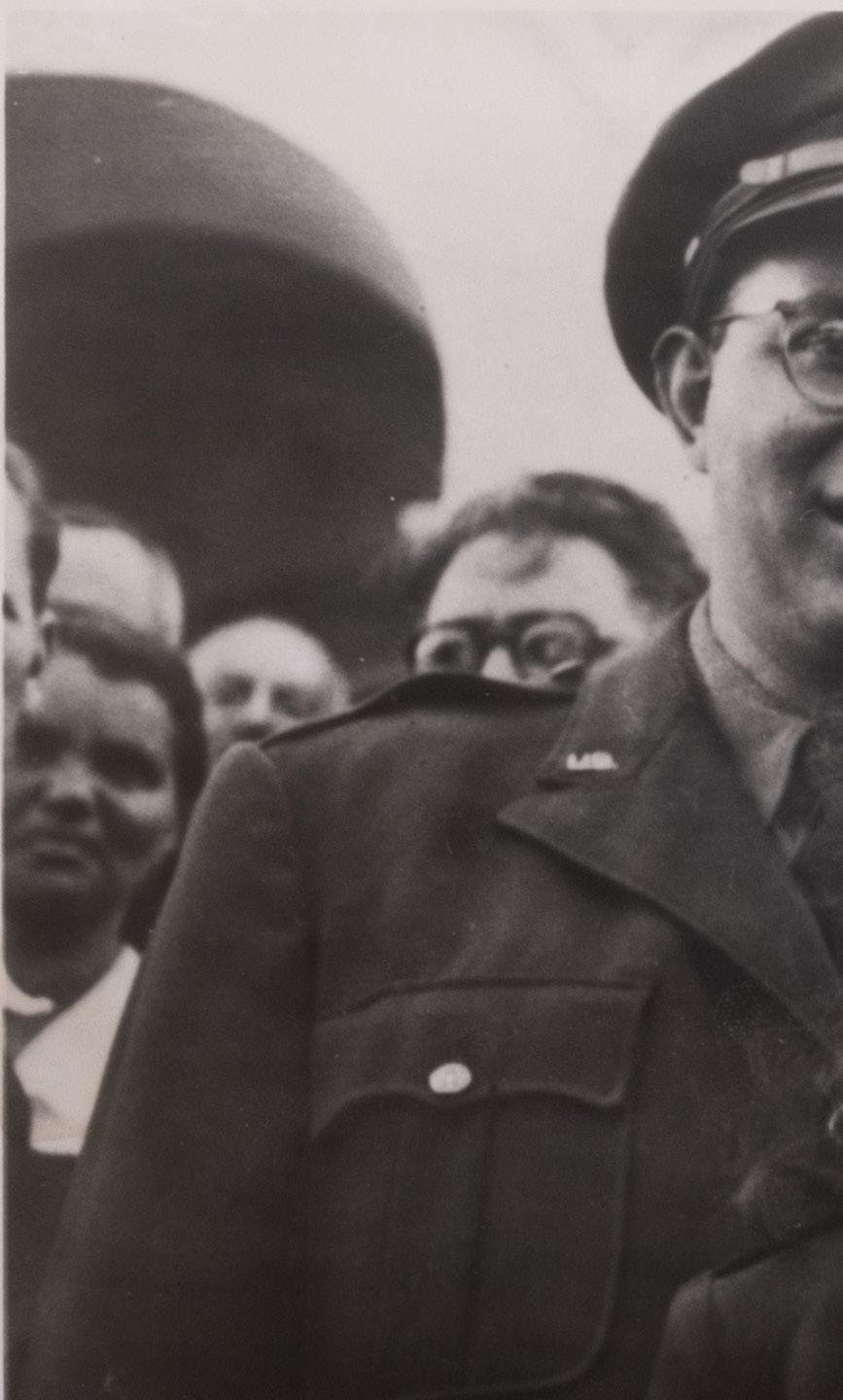
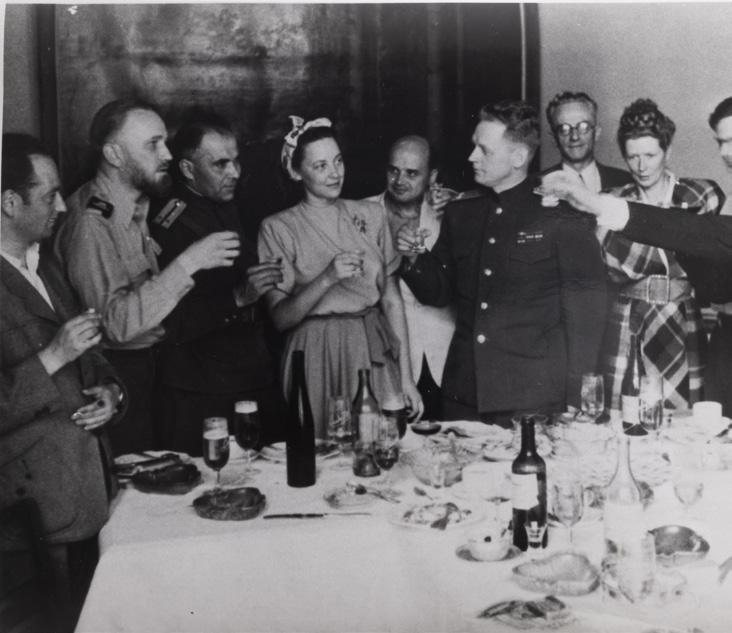
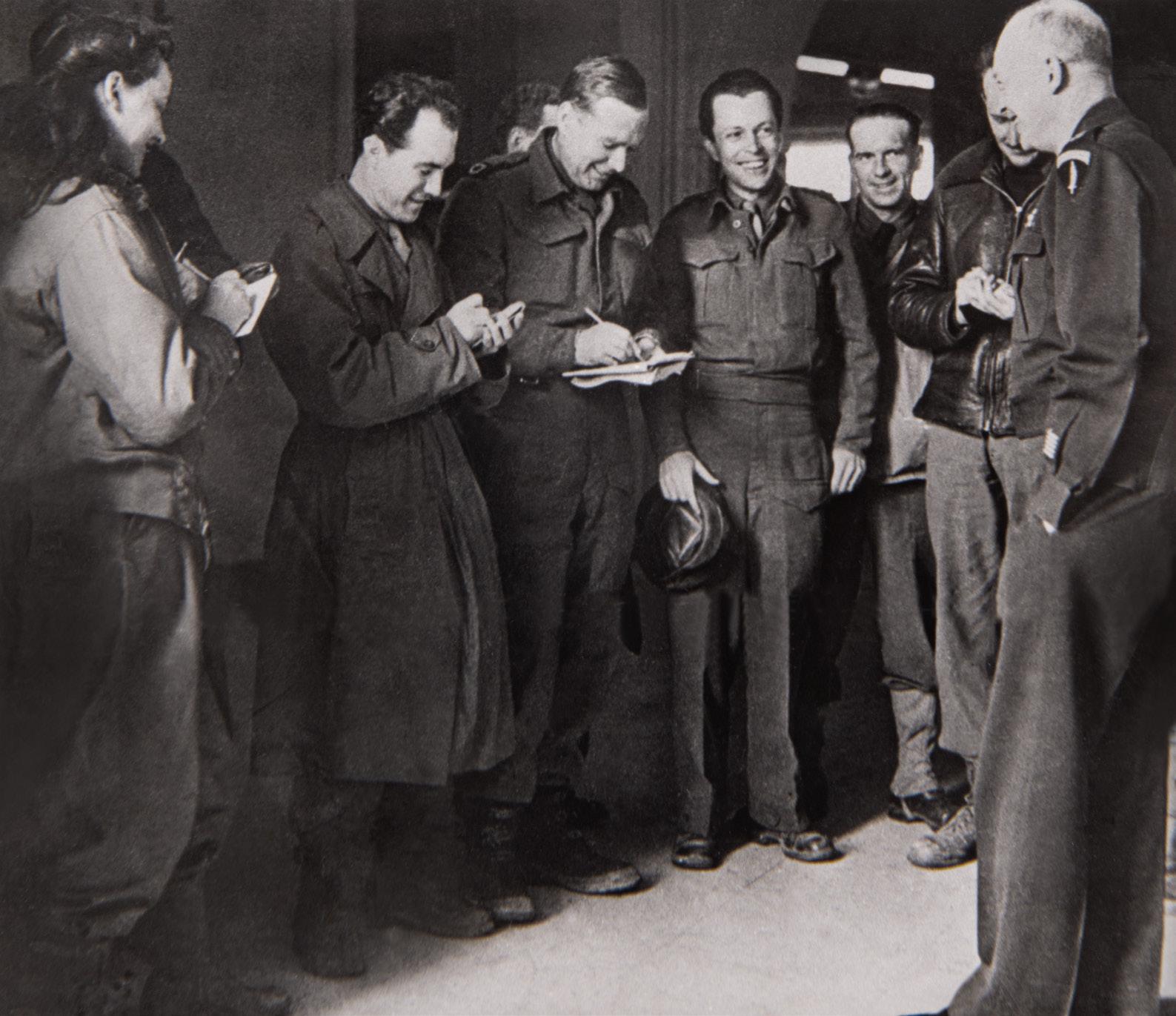
ANN STRINGER COLLECTION
(Above) News reporter Stringer stands among a half-circle of men for an impromptu interview with Gen. Dwight D. Eisenhower, the supreme commander of the Allied forces in Europe and leader of the Normandy invasion.
10 |
(Above) Pictured is a photo of Stringer from Transylvania, Romania. During World War II, “Romania became an ally of Nazi Germany and fought against the Soviet Union. In the last year of the war, Romania switched its alliance to the Soviets.”

Caption Source: Countries and their Cultures
(Left) Stringer, center, stands for a toast during a dinner with her Russian hosts on a tour of the Russian zone inside Germany.

(Above) Stringer was more than likely “the first woman war reporter to reach the front in Germany,” noted the United Press — and her news stories were among the “sharpest filed.”
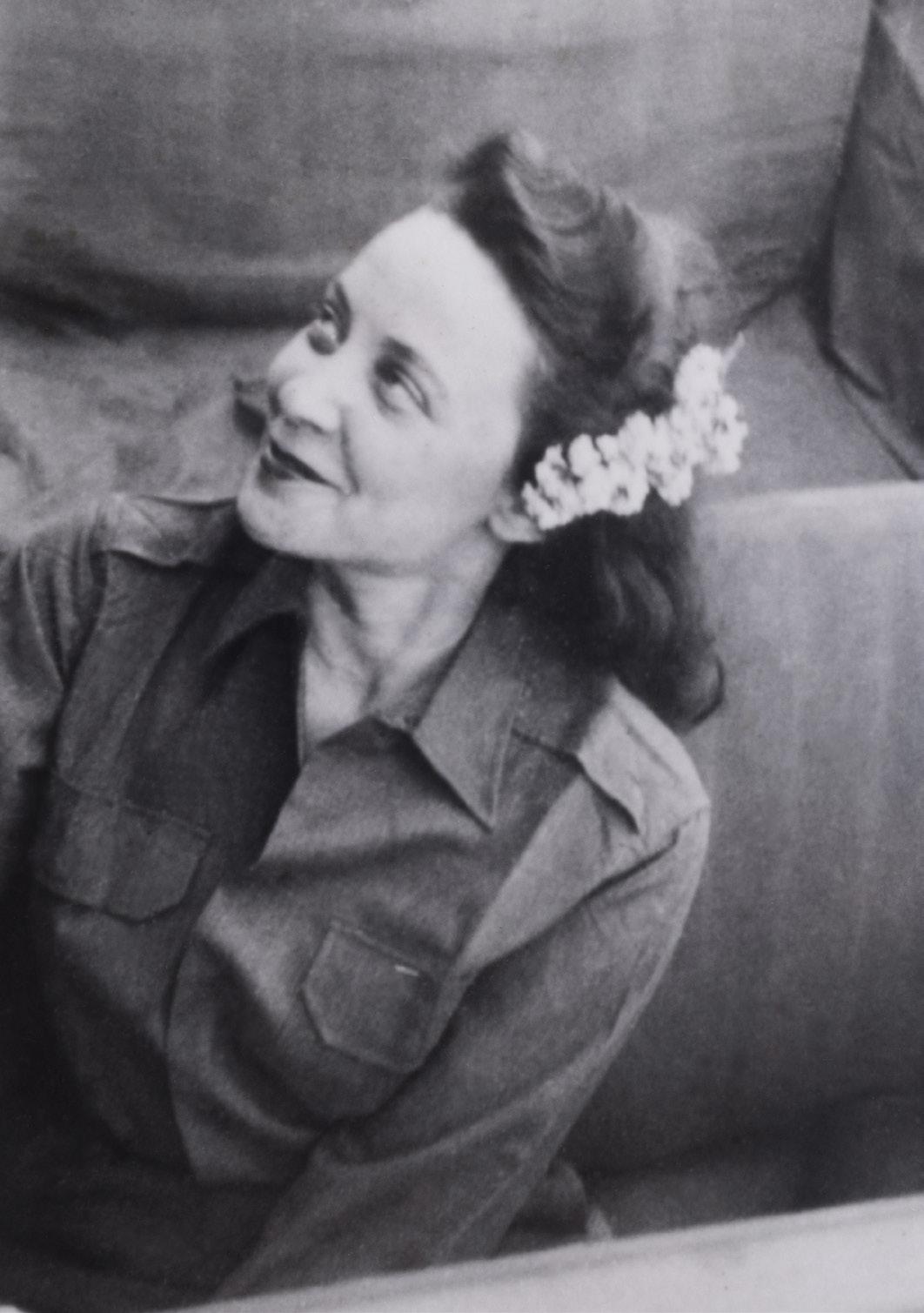
| 11
WALTER R. ERVIN COLLECTION
Athens local and POW survivor
World War II veteran and prisoner of war Walter R. Ervin was born in Greenbrier County, West Virginia. He moved to Athens, Ohio when he was five and graduated from Athens High School. He reported for duty with the U.S. Army in 1941. In March 1944, he shipped out to North Africa and then to Italy. On Aug. 15, 1944, he took part in Operation ANVIL, the invasion of southern France. Ervin was captured near Colmar, France in Jan. 1945 and spent the next two and a half months as a German prisoner of war. He was freed on May 11, 1945.
The collection includes correspondence, newspaper clippings, Army training manuals and song books.
(Right) Walter R. Ervin enlisted in the Army, trained as an infantry scout and then served under Lt. Gen. George Patton in the European and North African campaigns. Pictured is a group of soldiers taking time to shave — a discipline the military takes very seriously.
(Below) During Patton’s invasion of France, Ervin was captured and spent five months in one of the largest prisoner-of-war camps in Nazi Germany, Stalag VII. In May 1945, he was freed and later discharged with the rank of corporal. Pictured are some of Ervin’s personal items.

12 |
COLLECTION
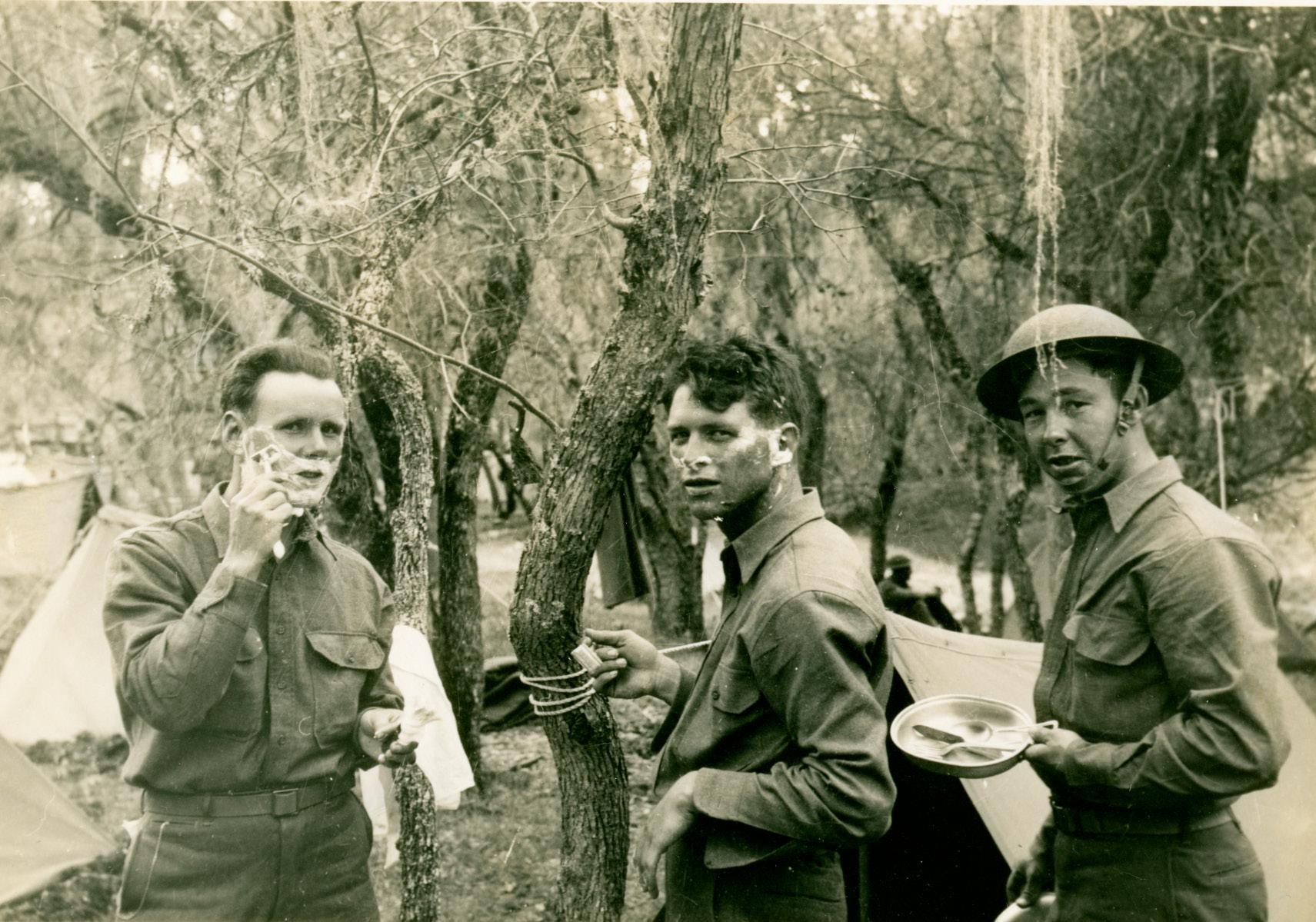
| 13
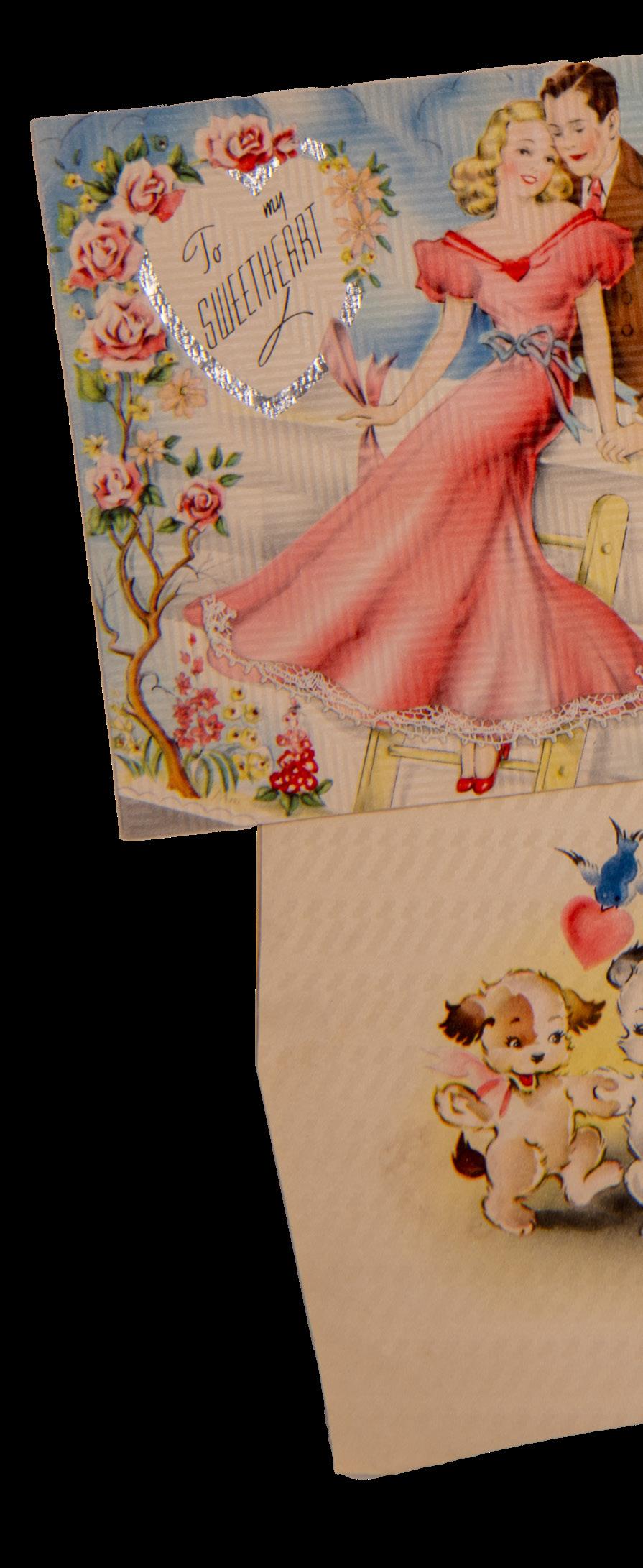
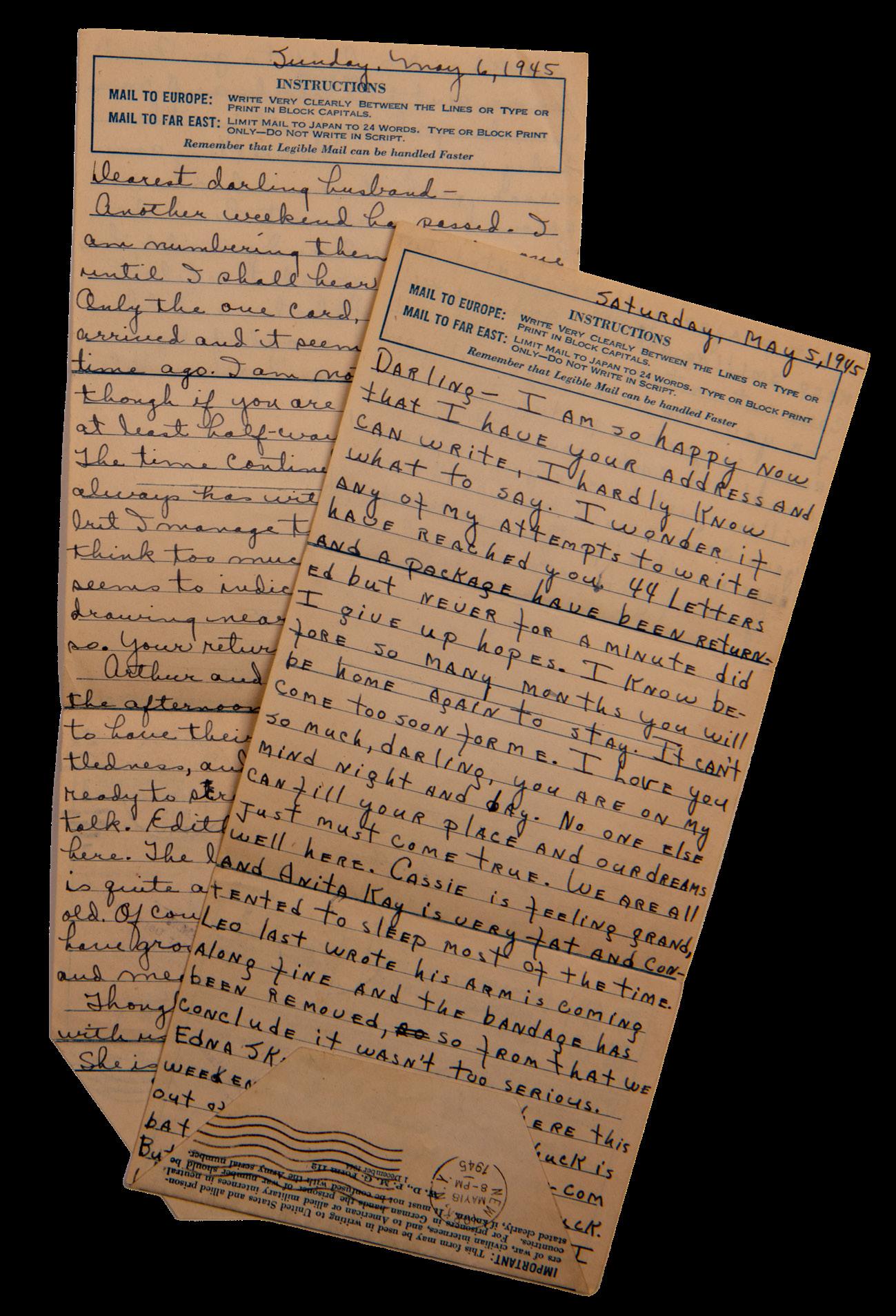
WALTER R. ERVIN COLLECTION 14 |
Married to Helen Sheridan, a 1939 alumna of Ohio University, Ervin’s exchange of letters and notecards with Helen was heightened during his time serving overseas.
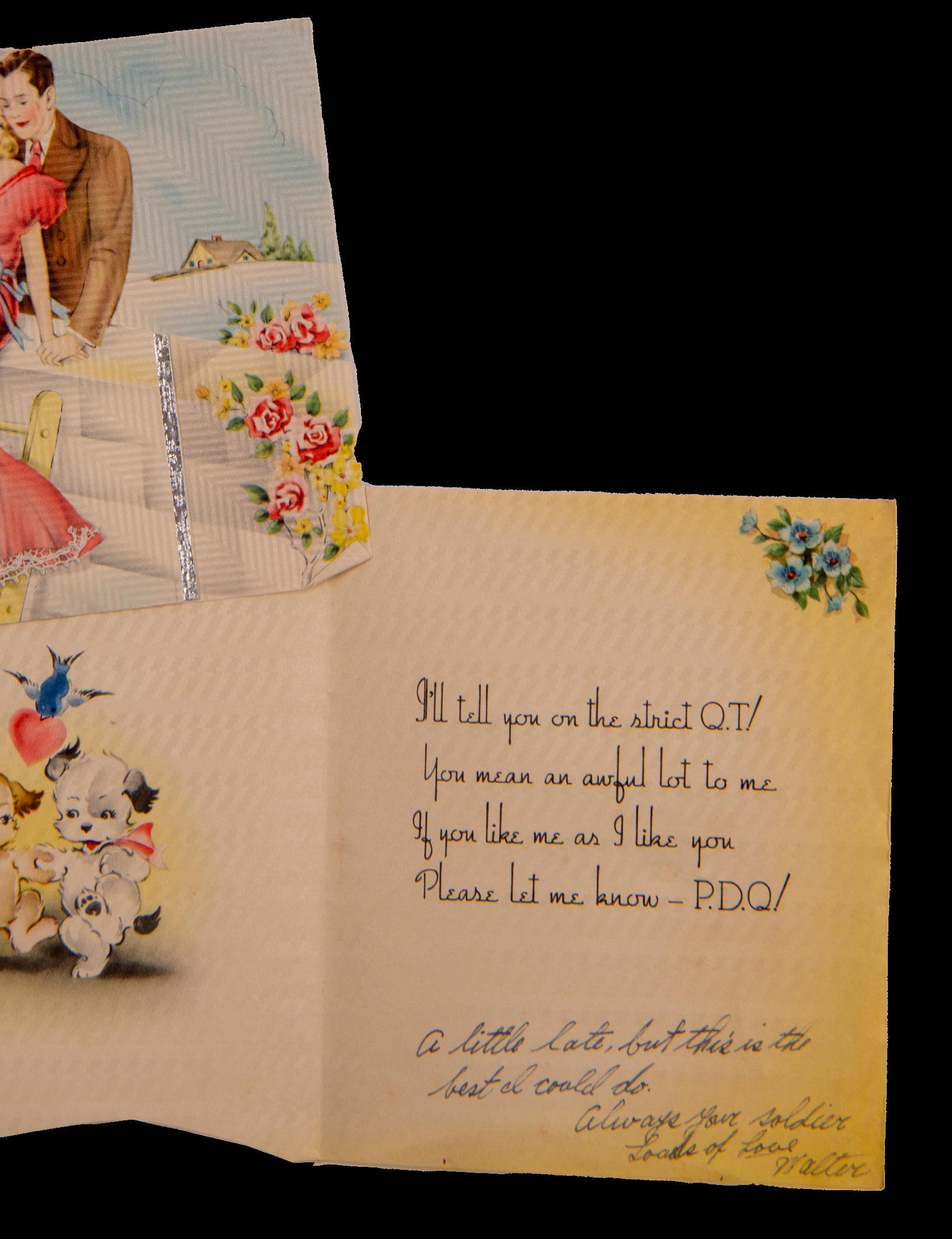
| 15
“I wonder if any of my attempts to write have reached you, 44 letters and a package have been returned but never for a minute did I give up hope.” – Helen Sheridan
British journalist and United States Army war correspondent
Iris Carpenter, a British journalist, was one of only two women officially allowed to cover the front lines of World War II. After being denied permission by the British Army to follow the war into continental Europe, she joined the United States Army as a war correspondent for the London Daily Herald, the British Broadcasting Corporation and the Boston Globe.

16 |
IRIS
IRIS CARPENTER TYPESCRIPT

(Above Left) Pictured is Carpenter’s typescript of her 1946 publication, “No Woman's World: From D-Day to Berlin, a Female Correspondent Covers World War II,” told through the eyes of a woman covering the front lines of war in a maledominated profession.

(Above Right) Pictured is the April 25, 1945, “Special Map Showing Contact Between Gen. Hodges’ First U.S. Army and Gen. Jadov’s Fifth U.S.S.R Army,” designating where the two armies met: Torgau, Germany.

(Left) Pictured is Carpenter’s well-worn leather luggage tag with this typewritten text, “Iris Carpenter, war correspondent, Daily Herald, London.”

| 17
WILLIAM H. CULVER JR. DIARY
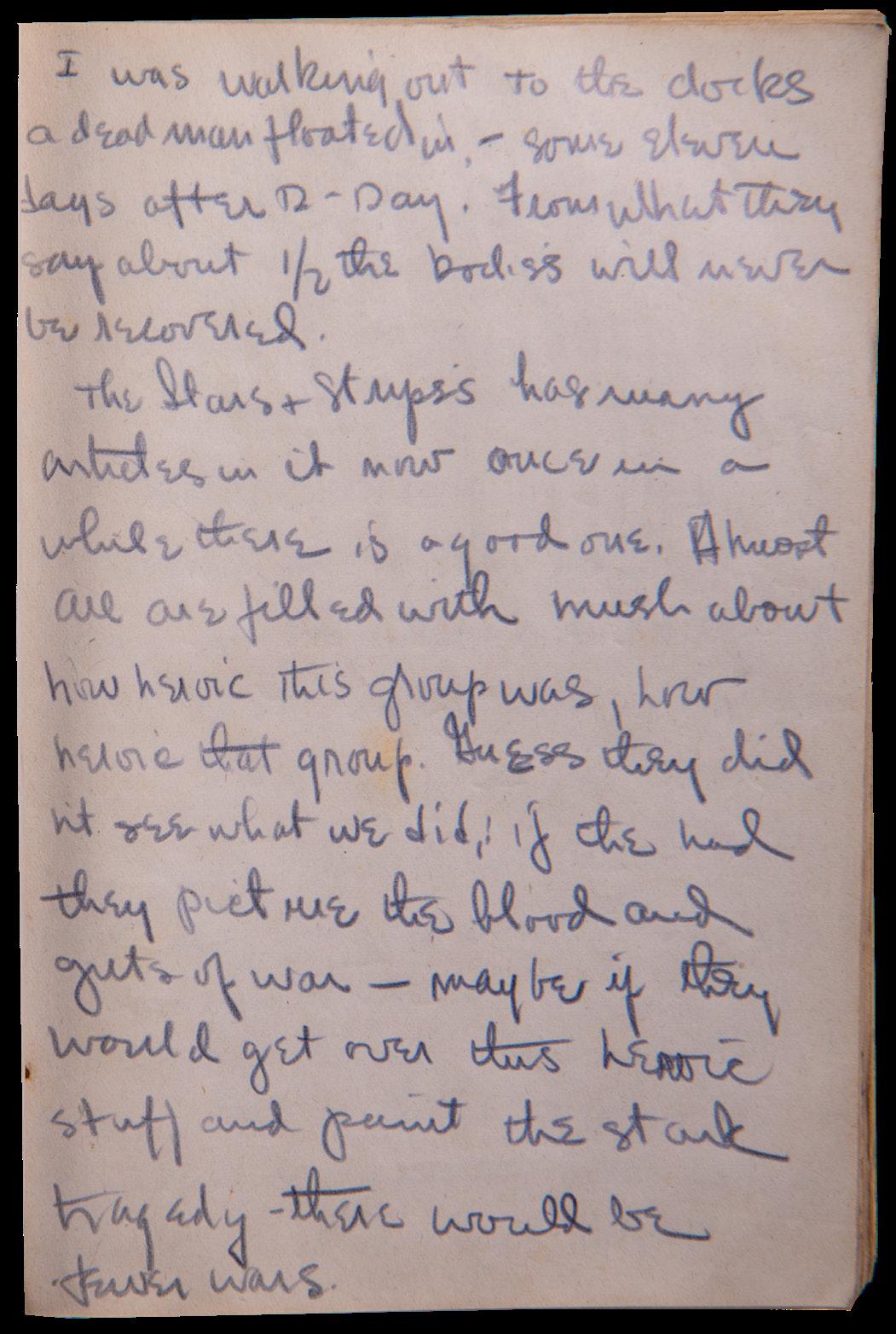

D-Day soldier and survivor
William H. Culver, Jr. was from Grand Rapids, Michigan. He was a lieutenant in the U.S Navy and a leader of team number two of a Naval Combat Demolition Group assigned to Dog Green, OMAHA Beach for the Normandy beach invasion on June 6, 1944. His collection consists of a single item – his diary where he writes about his experiences during and after D-Day.
18 |
“Maybe if they would get over this heroic stuff and paint the stark tragedy — there would be fewer wars.”
– William Culver
In the diary pictured here, which includes drawings and personal experiences, Culver writes in one excerpt about a dead man floating near the docks 11 days after D-Day. “Maybe if they would get over this heroic stuff and paint the stark tragedy — there would be fewer wars.”

DIARY
| 19
U.S. Army Air Corp member stationed in the Pacific
Marius P. Garofalo served in the U.S. Army Air Corp in the Pacific during and after World War II. He graduated from Ohio University in 1947 with a bachelor’s degree in education. The Garofalo collection documents the Pacific Theater of Operations through USO promotional materials regarding Hawaii, service newspapers and magazines, such as the Stars and Stripes. The collection focuses on the end of the war and the post war occupation.
COLLECTION
Pictured is the Dec. 25, 1945 humorous-souvenir edition of the Pacific Stars and Stripes magazine, whose “… front pages brought the big-picture news to the troops … while the inside pages told the stories of those same soldiers.”
Caption Source: Pacific Stars and Stripes

20 |
MARIUS P. GAROFALO
COLLECTION ON WORLD WAR II

(Above) During the holidays, the U.S. military made a concerted effort to send a hot meal to the front lines for soldiers all over the world. Pictured is the Nov. 1945 Thanksgiving menu being served in Tokyo, Japan.

(Left) Pictured is a typewritten copy of Appendix A of the “Instrument of Surrender.” The official document was signed by the Allied forces and Japan on Sept. 2, 1945.
Source: National Archives Foundation
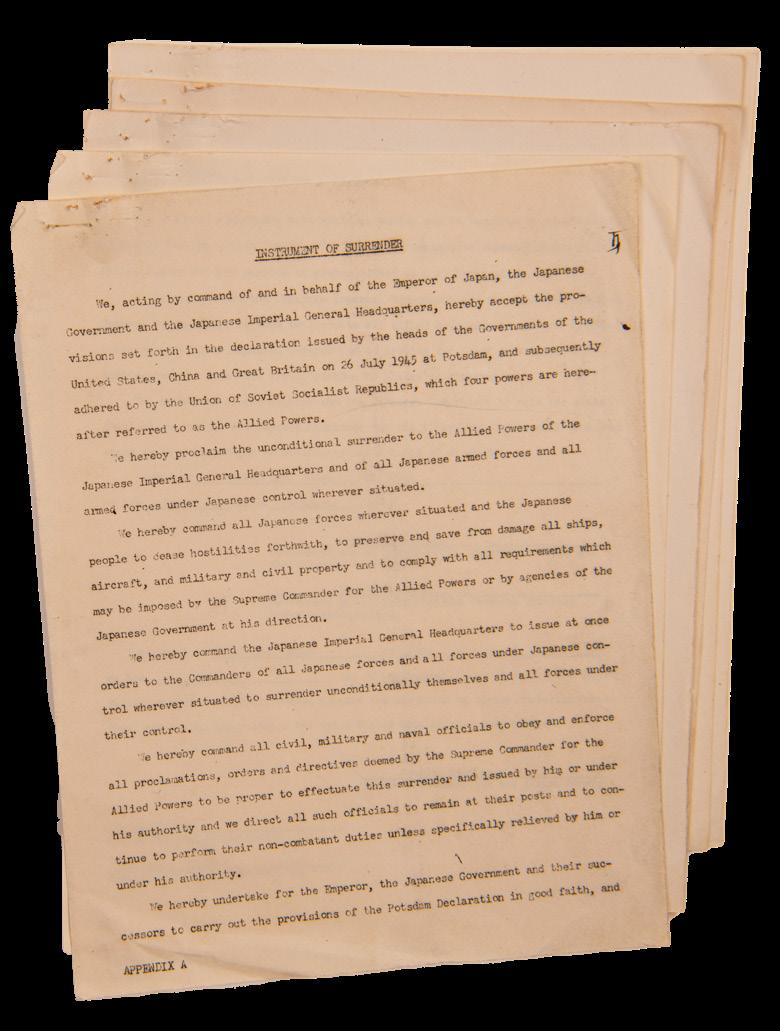
| 21
VICTOR H. BERNSTEIN PAPERS
PM war correspondent and author
American journalist Victor Bernstein worked for several newspapers. He is best known as a foreign editor of PM newspaper, covering the prewar persecution of the Jews in Germany and Austria, the collapse of Germany, the liberation of the concentration camps and the Nuremberg trials. He wrote the book, “Final Judgment, The Story of Nuremberg.”
Within the collection are eight scrapbooks of articles by Bernstein, photographs relating to the Nuremberg trials, press passes, Palestinian money, a United Nations scorecard of the votes which created Israel, a newsletter written by concentration camp survivors and a list of the dead at Buchenwald.
(Left) Pictured is the Nuremberg courtroom. The defendant’s box, filled with 21 seated men being charged with war crimes, is surrounded on three sides by military police. Bernstein writes the attached caption.
(Right) Soldiers, lined on both sides of a long hallway inside an industrial building, are each standing next to a prisoner’s cell door looking inside through a peephole. Bernstein writes the attached caption.

22 |

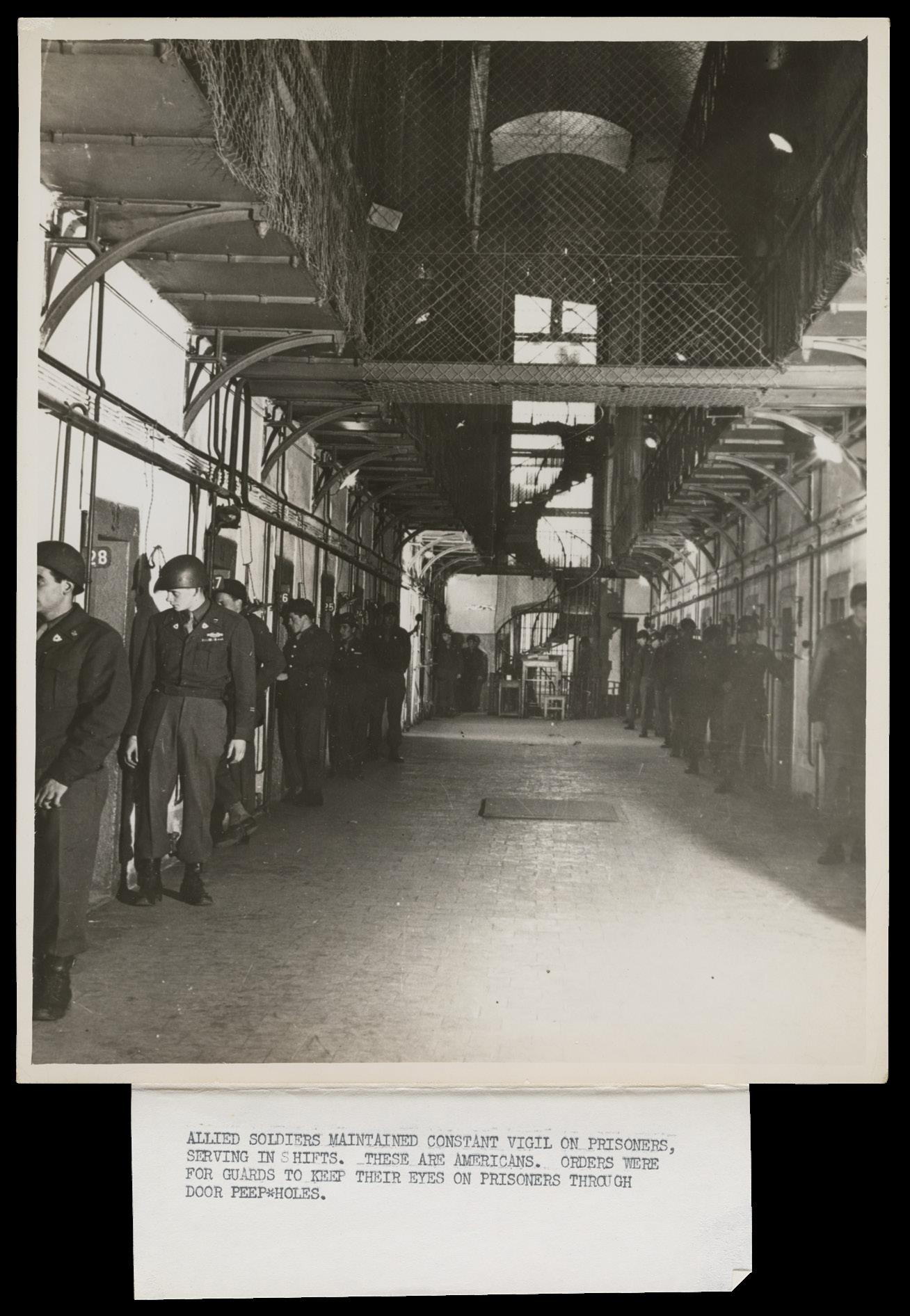
| 23
PAPERS

VICTOR H. BERNSTEIN PAPERS 24 |
(Left) Pictured are Bernstein’s press passes from Palestine, the International Military Tribunal and the International Military Tribunal’s Final Judgement, among others. Most passes are dated with a pre-selected seat number.
(Right) International coins and paper money are displayed along with the accompanying typewritten caption by Bernstein.

| 25
Doolittle Raider pilot from Dayton, Ohio
Richard “Dick” Cole was born in Dayton, Ohio. He completed two years at Ohio University and then attended Civilian Pilot Training and received his private pilot’s license. Cole took part in the Doolittle Raid on Tokyo, Japan on April 18, 1942. He remained in China until June 1943 flying bombing and transport missions over “The Hump,” Himalayan Mountains.
The papers include material from Cole and from Leona Hughes, who knew Cole when he attended OHIO. Since a Doolittle Raiders reunion in 1996, Hughes continued attending the reunions and adding materials related to Cole and the reunions to the collection.
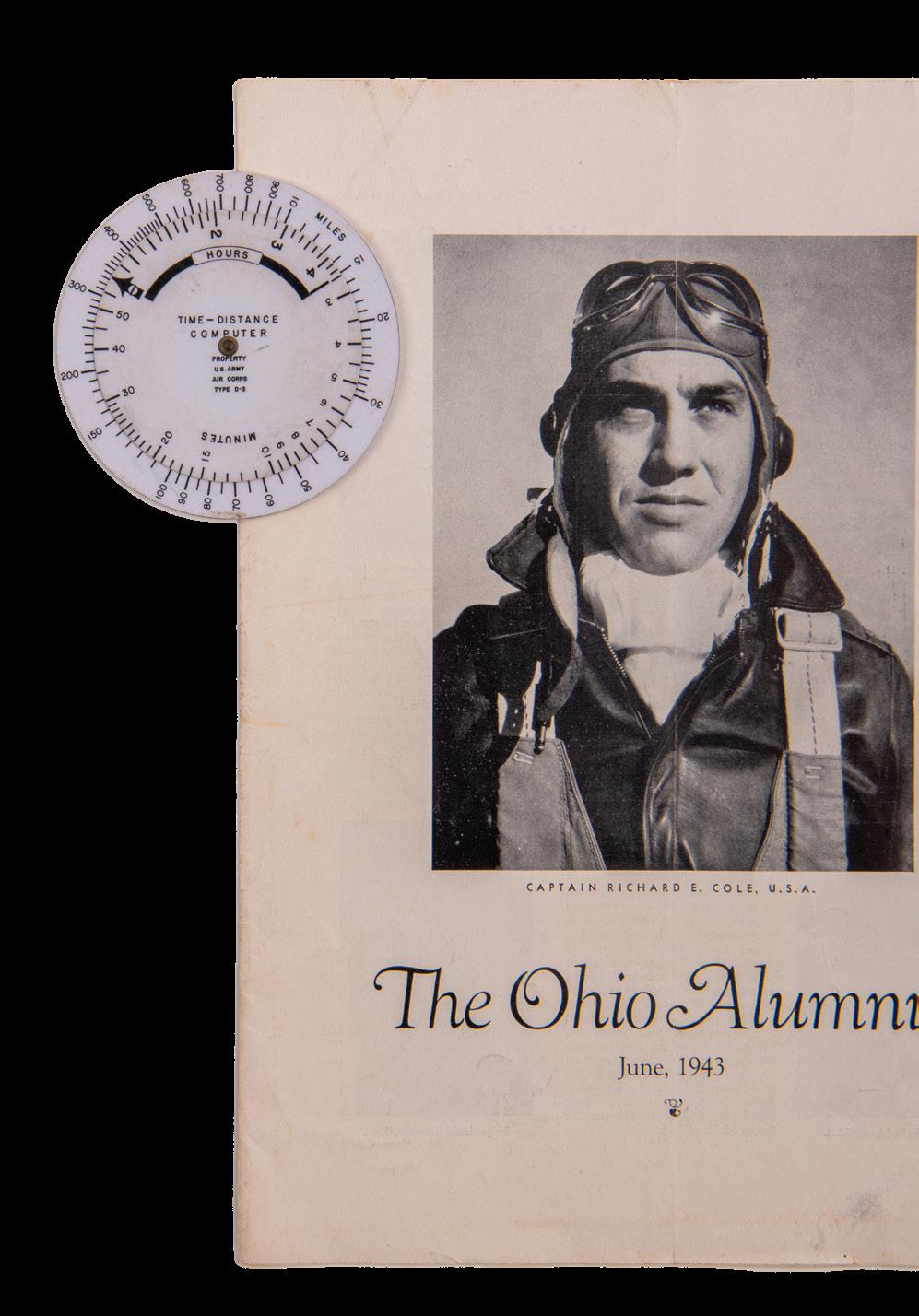
(Left) “Following the devastating attack on the fleet at Pearl Harbor, Lt. Col. Jimmy Doolittle was given the task of designing an attack on Tokyo, modifying a fleet of bombers so that they could take off from a carrier deck in the Pacific.”
Caption Source: OHIO News
(Right) “Official records and historical accounts vary on how far the raiders had to fly to reach their targets, but they launched more than 700 miles from the center of Tokyo and almost 10 hours sooner than planned.”
Caption Source: Air Force Magazine
26 |
RICHARD E. COLE PAPERS


| 27
ATHENS WAR LOAN SCRAPBOOKS
How did Athens County contribute to the war effort?

War Loan Drives were organized throughout the country to get citizens and corporations to purchase bonds in support of the war effort. Each state, county, township, city, town and village were assigned a quota of funds to be raised. The program was coordinated through the Treasury Department, which organized the War Finance Committees in the states. This collection consists of two scrapbooks documenting the fifth, sixth and seventh War Loan Drives held in Athens County during 1944 and 1945.
This scrapbook contains newspaper clippings and ephemera from Ohio University’s support of the sixth war loan program. Additionally pictured are a “Present Arms” program and a souvenir admissions ticket for the War Bond Premier of “Kismet.”
28 |
SCRAPBOOKS

Pictured is the front cover of a local Athens, Ohio scrapbook labeled, “Publicity for Fifth War Loan, June 12 to July 15, 1944.” The drives were organized nationwide to encourage financial support by citizens for the war effort.

| 29
U.S. Air Force vet and member of the Red Raiders
Delbert Kuhn was from Nelsonville, Ohio. He was a member of the 22nd Bomb Group, 19th Squadron in the Air Force during World War II. This group is part of the Red Raiders. He was stationed in New Guinea at one point. The Delbert Kuhn Papers span from 1942 to 1995 and document Kuhn’s participation in World War II and his membership in the Red Raiders. The papers include correspondence from Kuhn to family and friends in Ohio, brochures and newsletters to veterans of the Red Raiders.
(Top) Nicknamed the Red Raiders, the 22nd Bombardment Group was assigned to the Pacific Theater after Pearl Harbor under the command of Maj. Gen. George Kenney. Pictured in the upper lefthand corner of the letter is the illustrated Red Raiders emblem.
Caption Source: Pacific Wrecks (Bottom) The Kuhn Papers include correspondence between family and friends like the colorful postcard pictured here illustrating U.S. bomber planes, which was produced by the U.S. Navy.

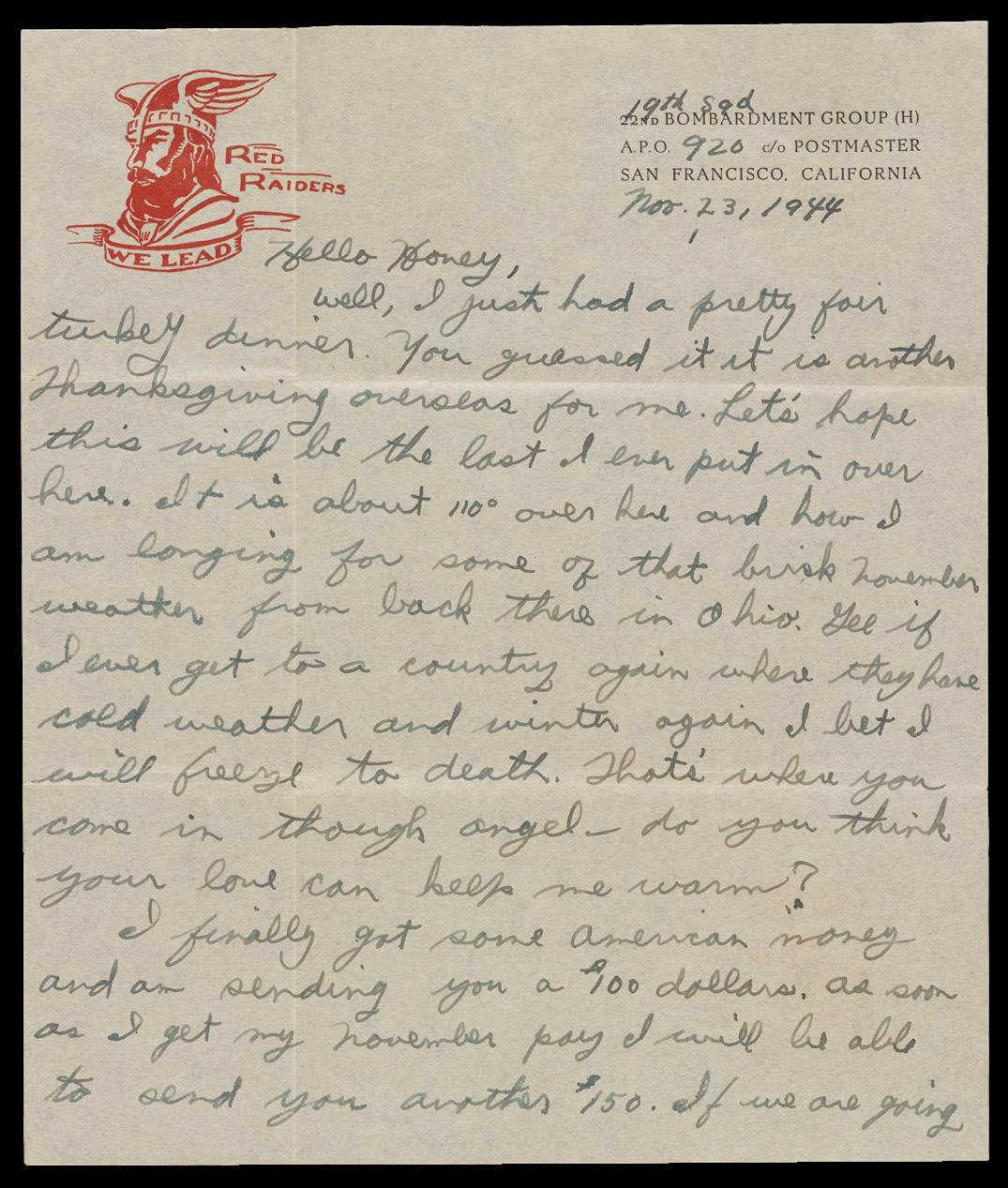
30 |
DELBERT KUHN PAPERS
Newsletters between veterans of World War II continued after the war ended. Pictured are five newsletters created by former military personnel from the 22nd Bomb Group dated between 1985-1995.

| 31
ALLAN CANNON WORLD WAR II SCRAPBOOKS
A ten-year-old follows the war from Ohio
In the village of Crooksville in Perry County, Ohio, ten-year-old Allan Cannon follows the action of World War II through newspaper clippings, maps and his own notes.
The Allan Cannon World War II Scrapbooks span from 1941 to 1945 and consist of three scrapbooks divided by topics. The first relates to Pearl Harbor, the second documents the overview of events beginning in 1941 to the end of 1942 and the third relates to the final stage of WWII with the victory over Germany on May 8, 1945.
During World War II, everyone wanted to be involved with the war effort. On the home front, one way to express that need was collecting news clippings in scrapbooks. Pictured are scrapbook pages compiled by 10-year-old Allan Cannon.

32 |
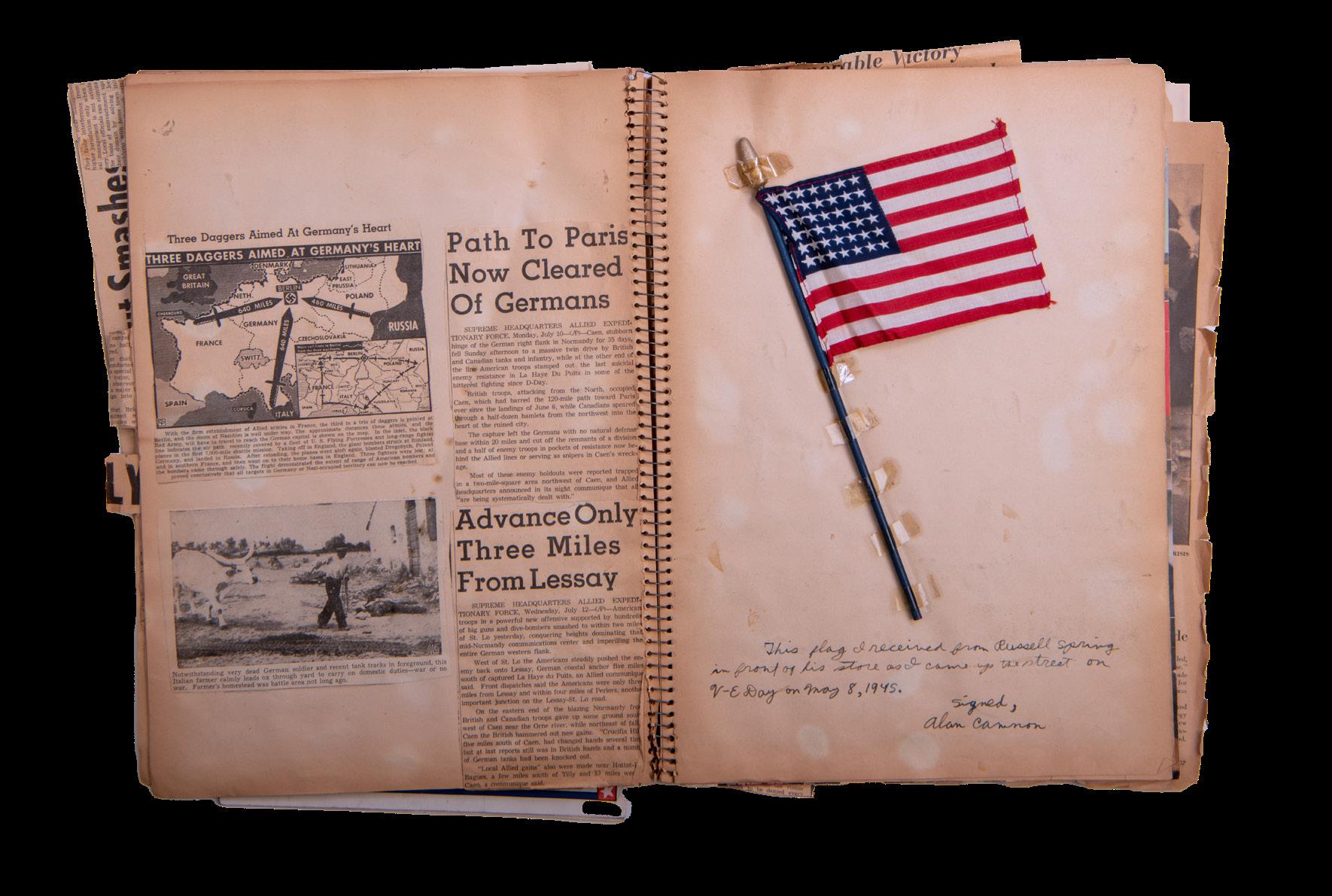


SCRAPBOOKS | 33
War correspondent and journalist
Doral Park Chenoweth was born in Palestine, West Virginia. He began his career in journalism early, writing for local newspapers starting at age 16. During World War II, Chenoweth served in Northern Africa, the Philippines and Panama as a press officer for the U.S. Army.
The main themes of the Chenoweth collection are war correspondents, journalists killed in action, international journalism, truth and facts and American soldiers in WWII.

On March 1, 1942, West Virginia’s National Guard was transferred to the Panama Canal and served as the U.S. Army's 150th Infantry Regiment until the end of World War II. Pictured are images of those soldiers in the canal and its surrounding area.
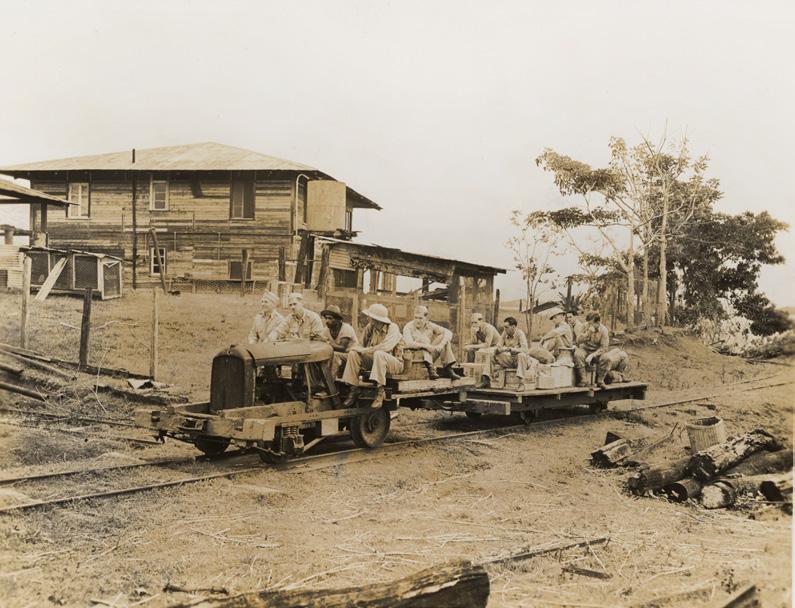

DORAL
34 |
DORAL CHENOWETH PAPERS
by Chenoweth about the necessity of protecting Panama after the attack on Pearl Harbor.
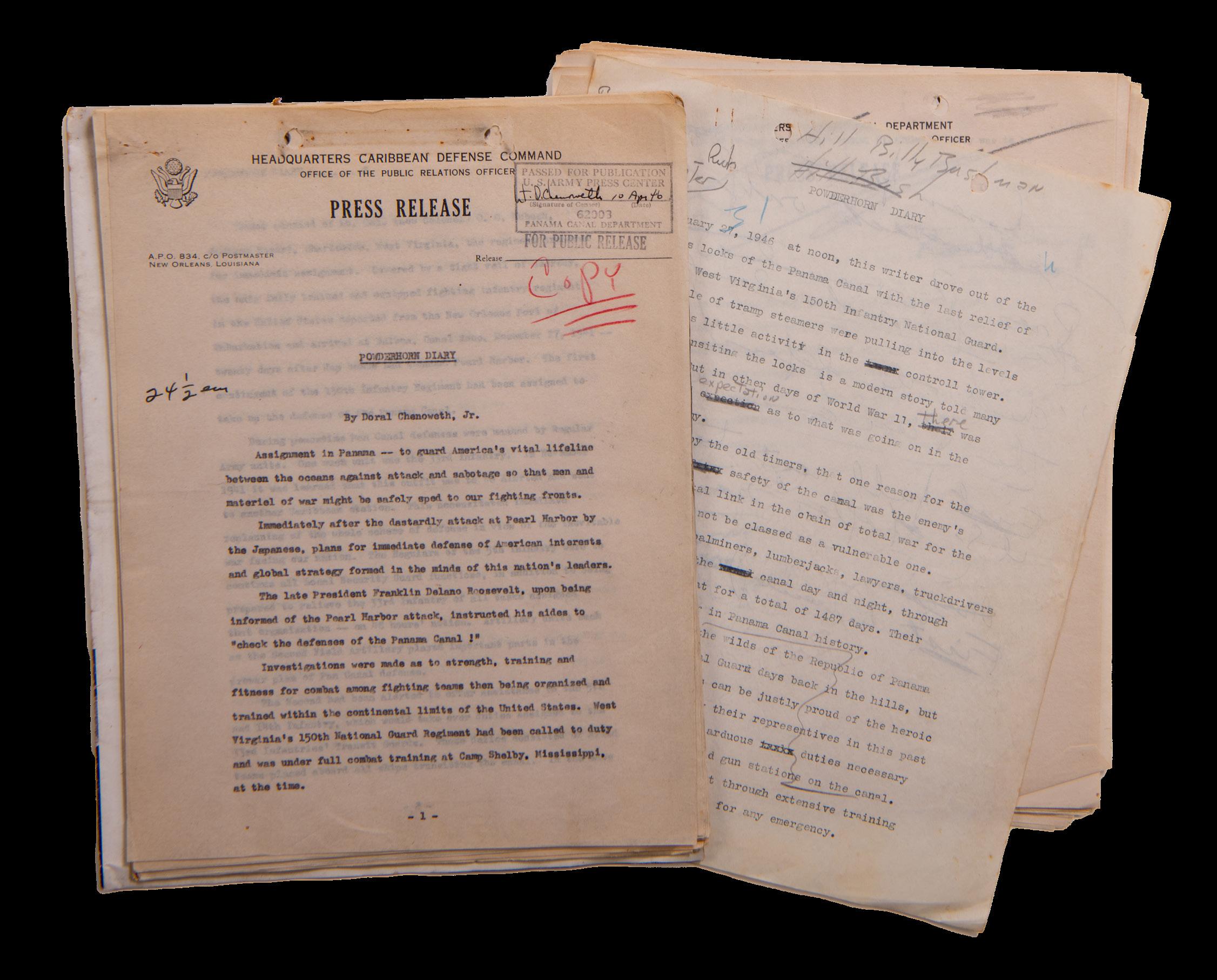
Caption Source: PBS, The War

| 35
GIFFORD DOXSEE PAPERS
Prisoner of war at Slaughterhouse Five
Gifford Doxsee was born in Bay Shore, New York. In 1942, he enlisted in the U.S. Army. During his service, he was a prisoner of war for five months in Dresden, Germany, where he would meet Kurt Vonnegut. Vonnegut’s novel, “SlaughterhouseFive,” reflects on their experience in Dresden.

The collection spans from the 1980s to the 2010s and is composed of publications, correspondence and various records from veteran organizations. Topics of the publications include Kurt Vonnegut, World War II research and veteran experiences during and after the war.
Gifford Doxsee, Jan. 10,
36 |
“I plan to begin to write the longest letter ever written to you to describe in detail my memories of my experiences during the Second World War, particularly in Europe and … [as] a prisoner of war.”
–
1981
(Left) Processed as a German POW, Doxsee was one of 150 men housed in “Building Number Five of the Dresden Slaughter-House Compound.” Pictured is a 1944 photo of Giff and his dog, Buddy.

Source: American Ex-Prisoners of War

| 37
A WAC in the Pacific
Phyllis Peirce was born in Worcester, Massachusetts. She was a WWII vet who served as a cryptanalysis technician with the Women’s Army Corps working in the Pacific Theater of Australia, New Guinea and the Philippines.
She began her army career in Nov. 1942 and trained to be a truck driver in Florida. She was then assigned to Fort Sill, Oklahoma, after which she was accepted for an overseas assignment.

Her collection includes scrapbooks, correspondence, photographs of family and friends from her time in the military, and an oral history transcript from the 1980s about her cryptanalysis work during WWII.

WORLD 38 |
PHYLLIS PEIRCE WORLD WAR II COLLECTION

In Nov. 1942, Peirce joined the Women’s Army Corp (WAC) and trained as a military truck driver before serving overseas in the Pacific Theater as a “code breaker” from 1944 until the summer of 1945. Four decades later, the National Security Administration conducted an oral history with Peirce and three other WACs. The transcript is included in this collection.

| 39
PHYLLIS PEIRCE WORLD WAR II COLLECTION
(Above) During World War II, receiving and sending news to the home front was a high priority for soldiers. With the onset of the new teletypewriter technology, messages could be read live with little delay time. Pictured is a Western Union telegram announcing Peirce’s arrival home.

Caption Source: We Are the Mighty
Peirce’s multiple scrapbooks and correspondence in the collection give a small glimpse of the destruction seen while serving in the U.S. military, which is demonstrated in these two stacked images.
40 |
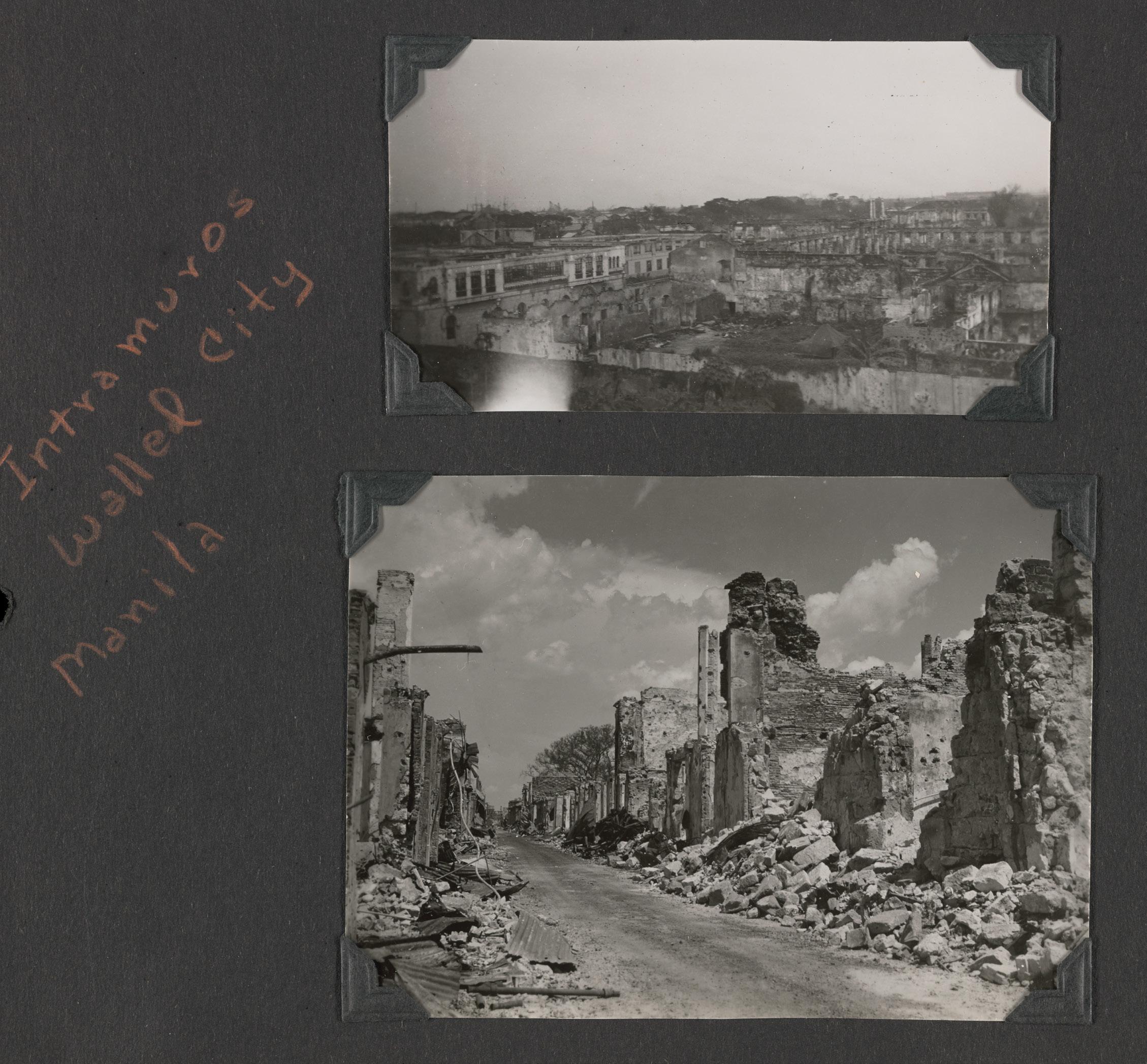
| 41
PHYLLIS PEIRCE WORLD WAR II COLLECTION
Pictured is a humorous ink and colored pencil line drawing of a WAC with an inside caption reading, “Edie sent me this one day. Said it would have to do until she got a snap[shot]. I don’t really look this bad.”

42 |
Special Thanks
to the staff at University Libraries’ Mahn Center and Digital Initiatives — and to the many people who made this publication possible.
Credits
Dean of University Libraries Neil Romanosky Editor Kate Mason coordinator of communications & assistant to the dean
Contributing editors
Greta Suiter manuscripts archivist Mimi Calhoun undergraduate communications assistant
Designers
Stacey Stewart associate director of design, University Communications and Marketing
Emily Baxstrom web content manager, University Communications and Marketing
Halie Best associate director of web content, University Communications and Marketing
For more information on the collections, please contact Greta Suiter at suiter@ohio.edu
| 43
Give today to help support University Libraries.
University Libraries
Under Gen. MacArthur, a campaign was launched against the Japanese occupation of what is now Papua New Guinea. The area was later a strategic air base, and for almost a year, is where Phyllis Peirce was stationed.
Caption Source: Facts and Details
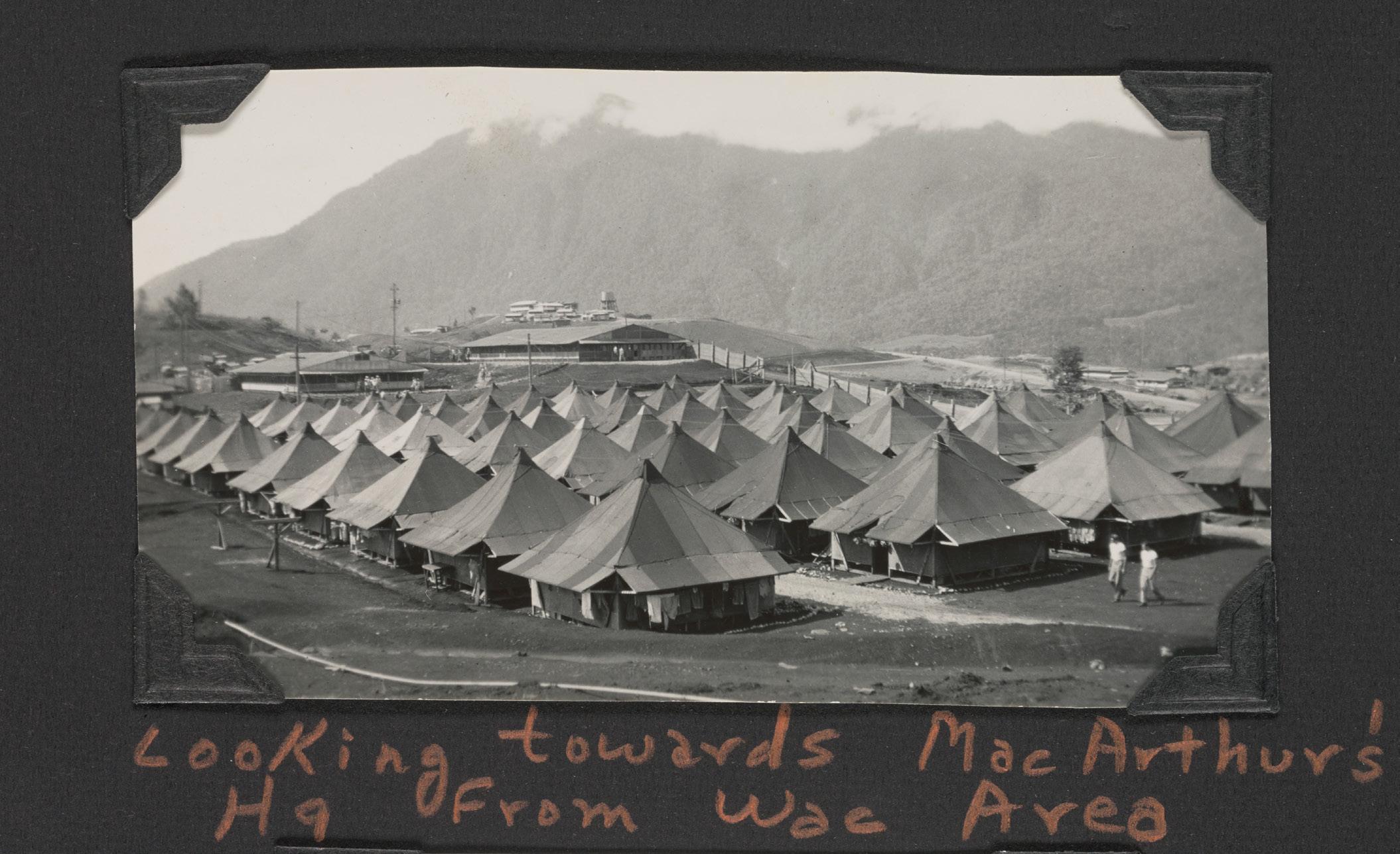


 Photo by Rich-Joseph Facun/Ohio University
Photo by Rich-Joseph Facun/Ohio University











































































